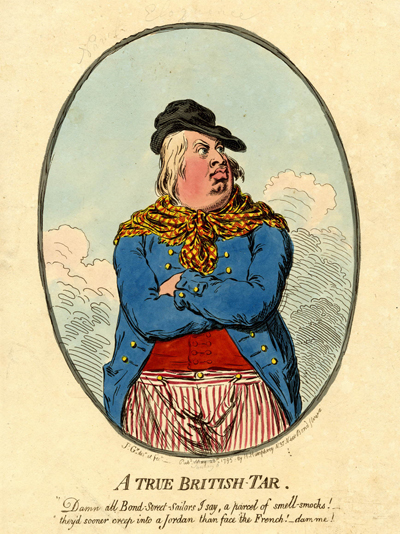A True British Tar
A True British Tar shows a belligerent-looking Prince William, the Duke of Clarence, dressed in common seaman's garb, supposedly berating fashionable and cowardly ("Bond Street") sailors who look the part of a seaman, but do not dare to engage the French.

© National Portrait Gallery, London
The print is an enlarged version of the image and caption of Naval Eloquence which Gillray had created five months earlier as part of the Eloquence series. But he has not just scaled up the original print from card size (~5" x 3") to portrait size (12" x 9"). He has also simplied the etched lines in both the background and figure of the Prince, brilliantly suggesting clouds and sky behind him with a few squiggles, and abandoning the use of stippling on the Prince's face and a roller or roulette on his jacket for simpler, freer, and more expressive lines added directly with the etching needle. The result is a superb and fully realized portrait caricature of the Duke of Clarence.
But however compelling the artistry of the print, like Naval Eloquence and the later Royal Lounger (1804), Gillray's message in A True British Tar remains the same. The belligerent caption is, of course, bitterly ironic, for by 1795 the Duke of Clarence was the embodiment of everything the caption rails against.
Damn all Bond St Sailors I say, a parcel of smell smocks! they'd sooner creep into a Jordan than face the French! dam me!
The Duke had not seen active service since 1790, but continued to collect ceremonial titles and live on his reputation as a naval man, even much later when he was known as "The Sailor King." The reference to creeping into a Jordan is no doubt intended to recall the Duke's (by now settled) relationship with the well-known actress, Mrs. Dorothea Jordan. But it may also have served the purpose of drumming up further business for Gillray's notorious 1791 print, Lubber's Hole, alias the Crack'd Jordan.

© National Portrait Gallery, London
To be fair, Prince William apparently applied for naval employment during the war with France, according to the British Museum commentary, but his applications were either denied or ignored. But Gillray is not interested in excuses. Indeed, he has a long history of contrasting the wealth and privilege of the Royals with the poverty and hardship of the common soldier or sailor.
Sources and Reading
- Commentary from the British Museum on A True British Tar
- "William IV of the United Kingdom," Wikipedia
- "Dorothea Jordan," Wikipedia
Comments & Corrections
NOTE: Comments and/or corrections are always appreciated. To make that easier, I have included a form below that you can use. I promise never to share any of the info provided without your express permission.